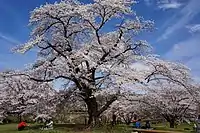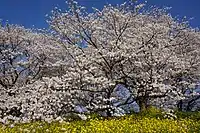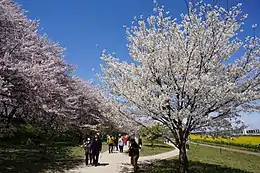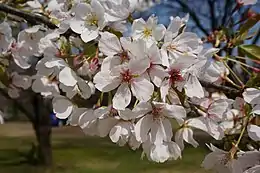Prunus × yedoensis
Prunus × yedoensis (synonym Cerasus × yedoensis) is a hybrid cherry tree between Prunus speciosa (Oshima cherry) as father plant and Prunus pendula f. ascendens (syn. Prunus itosakura, Prunus subhirtella var. ascendens, Edo higan) as mother.[1][2] It is a hybrid born in Japan and one of its cultivars, Prunus × yedoensis 'Somei-yoshino' or Yoshino cherry (Japanese: 染井吉野 ソメイヨシノ Somei Yoshino), is one of the most popular and widely planted cherry cultivars in temperate regions around the world today.[3][4] 'Somei-yoshino' is a clone from a single tree, and has been propagated by grafting all over the world.[5][6][7] 'Somei-yoshino' inherits Edo higan's quality of blooming before the leaves unfold and it growing into a large-sized tree. It also inherits the characteristics of the Oshima cherry, which grows rapidly and has white flowers. These characteristics are favored and have become one of the most popular cultivars of cherry trees.[8][9]
| Prunus × yedoensis | |
|---|---|
DSCF2986%E2%98%86%E5%BD%A1.jpg.webp) | |
| Cherry tree in full bloom (Tamba-Sasayama, Hyogo) | |
| Scientific classification | |
| Kingdom: | Plantae |
| Clade: | Tracheophytes |
| Clade: | Angiosperms |
| Clade: | Eudicots |
| Clade: | Rosids |
| Order: | Rosales |
| Family: | Rosaceae |
| Genus: | Prunus |
| Subgenus: | Prunus subg. Cerasus |
| Species: | P. × yedoensis |
| Binomial name | |
| Prunus × yedoensis | |
| Synonyms | |
| |
One of the spots where P. × yedoensis grows wild is around Funabara Pass on the Izu Peninsula, which is close to the birthplace of its paternal species, Oshima cherry, and the wild P. × yedoensis in the area and the cultivar developed from it are called 'Funabara-yoshino'.[10]
On April 1, 2019, the Kazusa DNA Research Institute, Shimane University and Kyoto Prefectural University announced that they had decoded all the genetic information of 'Somei-Yoshino', and it was revealed that 'Somei-yoshino' descended from Edo higan and Oshima cherry, as is commonly believed. It was also revealed that the two ancestral species separated into different species 5.52 million years ago, and that 'Somei-yoshino' was born by hybridization over 100 years ago.[11][12]
Although it was not recognized as a 'Somei-Yoshino' at the time of planting, the oldest verifiable record of a 'Somei-Yoshino' tree being planted is a record of its planting in the Koishikawa Botanical Garden in 1775. There are also existing 'Somei-Yoshino' trees planted in Koishikawa Botanical Garden in 1875, in Kaiseizan Park in Kōriyama, Fukushima Prefecture in 1878, and in Hirosaki Castle in 1882, which are sometimes referred to as the oldest 'Somei-Yoshino' trees.[8][13] As of 2019, the Tree Health Research Society, Japan has recognized the oldest surviving 'Somei-Yoshino' in Japan, the one on Kaiseizan Park planted in 1878, based on the results of radiocarbon dating and other scientific studies.[14]
Names

In 1900, Yorinaga Fujino gave the Yoshino cherry the name Somei-yoshino after the famous place of cultivation, Somei village (current day Toshima) and famous place of Prunus jamasakura, Mount Yoshino.[15] In 1901, Yoshino cherry was given a scientific name Prunus yedoensis by Jinzō Matsumura.[16] However, after Ernest Henry Wilson suggested Yoshino cherry is a hybrid between Prunus subhirtella var. ascendens (Edo higan) and Prunus lannesiana (Oshima cherry) in 1916,[17] Yoshino cherry came to be called Prunus × yedoensis.[18] As for the Korean native cherry called King cherry which was given a scientific name Prunus yedoensis var. nudiflora by a German botanist Bernhard Adalbert Emil Koehne in 1912 continues to be called Prunus yedoensis.[19][20]
The Yoshino cherry has no scientific cultivar name because it is the original cultivar of this hybrid species Prunus × yedoensis. A new name, 'Somei-yoshino' is proposed in accordance with other cultivars of Prunus × yedoensis.[21]
Description

Prunus × yedoensis is a small, deciduous tree that grows to be 5 to 12 meters (16–39 ft) (rarely 15 meters (49 ft)) tall at maturity. It grows well in hardiness zones 5–8, and does well in full sun and moist but well-drained soil. The leaves are alternately arranged, 6 to 15 centimeters (2.4–5.9 in) long and 4 to 7 centimeters (1.6–2.8 in) broad, with a serrated margin; they are often bronze-toned when newly emerged, becoming dark green by summer.
The flowers emerge before the leaves in early spring; they are fragrant, 3 to 3.5 centimeters (1.2–1.4 in) in diameter, with five white or pale pink petals. The flowers grow in clusters of five or six together.
The fruit, a small cherry, is a globose drupe 8 to 10 millimeters (0.31–0.39 in) in diameter; they are an important source of food for many small birds and mammals, including robins and thrushes. Although the fruit contain little flesh, it contains much concentrated red juice which can stain clothing and bricks. The fruit is only marginally sweet to the human palate.[3][4]
Cultivation
With its fragrant, light pink flowers, manageable size, and elegant shape, the Yoshino cherry is often used as an ornamental tree. Many cultivars have been selected; notable examples include 'Akebono' (or 'America' in Japan), 'Ivensii', and 'Shidare Yoshino'.[3]
From the Edo period to the beginning of the Meiji period, gardeners and craftsman who made the village at Somei in Edo (now Komagome, Toshima ward, Tokyo) grew someiyoshino. They first offered them as Yoshinozakura, but in 1900, they were renamed someiyoshino by Dr. Fujino.[22] This is sometimes rendered as 'Somei-Yoshino'.
The Yoshino cherry was introduced to Europe and North America in 1902.[23] The National Cherry Blossom Festival is a spring celebration in Washington, D.C., commemorating the 1912 gift of Japanese cherry trees from Tokyo to the city of Washington. They are planted in the Tidal Basin park. Several of 2,000 Japanese cherry trees given to the citizens of Toronto by the citizens of Tokyo in 1959 were planted in High Park. Pilgrim Hill in New York City's Central Park is popular for its groves of pale flowering Yoshino cherry trees as they burst into bloom in the spring.[24][25]
 Yoshino cherry in Shinjuku Gyo-en.
Yoshino cherry in Shinjuku Gyo-en. Yoshino cherry in Hitsujiyama park, Chichibu, Saitama.
Yoshino cherry in Hitsujiyama park, Chichibu, Saitama. Yoshino cherry in Yoshimi, Saitama.
Yoshino cherry in Yoshimi, Saitama. Yoshino cherry
Yoshino cherry Yoshino cherry
Yoshino cherry
Parental species


Most studies show that Yoshino cherry ('Somei-yoshino') is a hybrid between Prunus speciosa (Oshima cherry) and Prunus pendula f. ascendens. (syn. Prunus itosakura, Prunus subhirtella var. ascendens, Edo higan).
- In 1916, Ernest Henry Wilson concluded that Yoshino cherry strongly suggests a hybrid between Prunus subhirtella var. ascendens Wilson (Edo higan) and Prunus lannesiana Wilson (Oshima cherry). It has many characters of the latter and in its venation, pubescence and shape of the cupula resembles the former[17]
- In 1963, Takenaka assumed that Yoshino cherry is a hybrid between Prunus lannesiana var. speciose (Oshima cherry) and Prunus subhirtella var. pendula form ascendens (Edo higan).[26]
- In 1986, Takafumi Kaneko et al. carried out restriction endonuclease analysis on chloroplast ctDNA. Yoshino cherry showed no interplant variation of ctDNA and had the same ctDNA as P. pendula (Edo higan), differing from P. lannesiana (Oshima cherry) by a single HindIII restriction site. This findings suggests that P. pendula is female parent of P. yedoensis.[27]
- In 1995, Hideki Innan et al. conducted DNA fingerprinting study using different kinds of probes, M13 repeat sequence and (GACA)4 synthetic oligonucleotide and concluded that Yoshino cherry was produced only once through hybridization between Prunus lannesiana (Oshima cherry) and Prunus pendula (Edo higan) and that this particular hybrid plant has been spread vegetatively all over Japan,[5]
- In 2014, Shuri Kato et al. conducted molecular analysis using nuclear simple sequence repeat (SSR) polymorphisms to trace cultivar origins and Bayesian clustering based on the STRUCTURE analysis using SSR genotypes revealed that Yoshino cherry is a hybrid between Prunus pendula f. ascendens (Edo higan) and Prunus lannesiana var. speciosa (Oshima cherry) although there was also a small and nonsignificant association with Prunus jamasakura. The proportion of each species is Edo higan 47%, Oshima cherry 37%, and jamasakura 11%.[28]
- In 2015, Ikuo Nakamura et al. analyzed sequences of intron 19 and exon 20 of PolA1. One of two exon 20 sequences found in Yoshino cherry was the same as that of P. pendula (Edo higan), whereas the other sequence was shared with several taxa in seven wild species, including P. jamasakura (Yamazakura) and P. lannesiana (Oshima cherry). Yoshino cherry contained two different haplotypes of the intron 19 sequences; one was the same as that of Oshima cherry. While another haplotype of Yoshino cherry was different from that of Edo higan by two SNPs but identical to one of two haplotypes of P. pendula ‘Komatsuotome,’ which is a cultivar of Edo higan. These results indicated that Yoshino cherry probably originated by the hybridization of cultivars derived from Edo higan and Oshima cherry.[29]
Origin debates
- In 1908, a French missionary Taquet discovered a native cherry in Jeju islands, Korea and in 1912 a German botanist Koehne gave it a scientific name Prunus yedoensis var. nudiflora.[30] Although this species called Eishu zakura is a variation of Yoshino cherry ('Somei-yoshino'), from then it was misrepresented that Yoshino cherry was growing naturally in Jeju Island.[31]
- In 1933, the Japanese botanist Gen'ichi Koizumi reported that Yoshino cherry originated on Jeju island, South Korea.[31] Koreans claimed that the Japanese stole Yoshino cherry from South Korea at the time of Japanese annexation of Korea.
- In 1962, Yo Takenaka ruled out the possibility of Korean origin by the morphological study.[26][32]
- In 1995 DNA fingerprinting technology was used to conclude that Yoshino cherry grown in many parts of Japan under the name Prunus × yedoensis is indeed clonally propagated from the same hybrid offspring of Prunus lannesiana (Oshima cherry) and Prunus pendula (Edo higan),[5] which confirms the 1991 conclusion given by Iwasaki Fumio that Prunus × yedoensis originated around 1720–1735 by artificial crossing of these species in Edo (Tokyo).[33] Oshima cherry is an endemic species found only around Izu Islands, Izu and Bōsō Peninsulas not around Korean Peninsula.[34][35]
- In 2007, a study conducted on the comparison of Japanese Yoshino cherry and Korean King cherry concluded that the trees native to these two places can be categorized as distinct species.[20] It was confirmed that South Korea's claim was false.
- In 2016, the phylogenetic analysis of nrDNA ITS data and the cpDNA haplotype network analysis suggested that independent origin between King cherry and yoshino cherry, respectively.[36]
- In 2016, a new scientific name Cerasus × nudiflora was given to King cherry to distinguish it from Yoshino cherry (Prunus × yedoensis).[37]
Other cultivars
Prunus × yedoensis has many cultivars other than 'Somei-yoshino' (Yoshino cherry).[28]

- ‘Amagi-yoshino’ (天城吉野)
- ‘America’ (アメリカ) (or 'Akebono' in the U.S.)
- ‘Candida’ (薄毛大島, Usuge-oshima)
- ‘Funabara-yoshino’ (船原吉野)
- ‘Hayazaki-oshima’ (早咲大島)
- ‘Izu-yoshino’ (伊豆吉野)
- ‘Kichijouji’ (吉祥寺)
- ‘Kurama-zakura’ (鞍馬桜)
- ‘Mikado-yoshino’ (御帝吉野)
- ‘Mishima-zakura’ (三島桜)
- ‘Morioka-pendula’ (盛岡枝垂, Morioka-shidare)
- ‘Naniwa-zakura’ (浪速桜)
- ‘Pendula’ (枝垂大臭桜), Shidare-ookusai-zakura
- ‘Perpendens’ (枝垂染井吉野, Shidare-somei-yoshino)
- ‘Pilosa’ (毛大島桜, Ke-oshima-zakura)
- ‘Sakabai’ (仙台吉野, Sendai-yoshino)
- ‘Sakuyahime’ (咲耶姫)
- ‘Sasabe-zakura’ (笹部桜)
- ‘Shouwa-zakura’ (昭和桜)
- ‘Somei-higan’ (染井彼岸)
- ‘Somei-nioi’ (染井匂)
- ‘Sotorihime’ (衣通姫)
- ‘Suruga-zakura’ (駿河桜)
- ‘Syuzenzi-zakura’ (修善寺桜)
- ‘Waseyoshino’ (早生吉野)
- ‘Somei-beni’ (染井紅)
See also
- Cherry blossom (sakura)
References
- Satoshi Ohta; Shinsuke Osumi; Toshio Katsuki; Ikuo Nakamura; Toshiya Yamamoto; Yo-Ichiro Sato (2006). "Genetic characterization of flowering cherries (Prunus subgenus Cerasus) using rpl16-rpl14 spacer sequences of chloroplast DNA". 園芸雑誌(J. Japan. Soc. Hort. Sci.). 75 (1): 72–78. doi:10.2503/jjshs.75.72. Retrieved 2011-04-06.
- Online Resource 5. Inferences, from morphological classification and STRUCTURE analysis, on the origins of Japanese flowering cherry cultivars p.7 ‘Yedoensis’/染井吉野 (Cer194) 、STRUCTURE analysis (K = 11)、 Tree Genetics & Genomes Volume 10, Issue 3(2014), pp 477–487、30 Jan. 2014、Supplementary Material (5) 11295_2014_697_MOESM5_ESM.pdf (318KB)
- Huxley, A., ed. (1992). New RHS Dictionary of Gardening. Macmillan ISBN 0-333-47494-5.
- Rushforth, K. (1999). Trees of Britain and Europe. Collins ISBN 0-00-220013-9.
- H. Innan, R.Terauchi, NT Miyashita, K Tsunewaki (1995). "DNA fingerprinting study on the intraspecific variation and the origin of Prunus yedoensis (Someiyoshino)". Japanese Journal of Genetics. 70 (2): 185–196. doi:10.1266/jjg.70.185. PMID 7605671.
{{cite journal}}: CS1 maint: multiple names: authors list (link) - Iketani, H.; et al. (2007). "Analyses of clonal status in 'Somei-yoshino' and confirmation of genealogical record in other cultivars of Prunus ×yedoensis by microsatellite markers". Breeding Science. 57: 1–6. doi:10.1270/jsbbs.57.1.
- SAKURA TRUTH - Time and Tide | NHK WORLD-JAPAN On Demand, retrieved 2023-04-04
- Toshio Katsuki. (2015) Sakura. pp40-42. 77. Iwanami Shoten. ISBN 978-4004315346
- Toshio Katsuki. (2015) Sakura. pp.178-182. Iwanami Shoten. ISBN 978-4004315346
- Toshio Katsuki. (2015) Sakura. p64. Iwanami Shoten. ISBN 978-4004315346
- ソメイヨシノのゲノム解読に成功、開花時期の予測が可能に (in Japanese). University Journal Online. 1 April 2019. Archived from the original on 7 April 2021.
- Kenta Shirasawa, Tomoya Esumi, Hideki Hirakawa, Hideyuki Tanaka, Akihiro Itai, Andrea Ghelfi, Hideki Nagasaki, Sachiko Isobe (12 March 2019). "Phased genome sequence of an interspecific hybrid 2 flowering cherry, Somei-Yoshino (Cerasus × yedoensis)" (PDF). doi:10.1101/573451. S2CID 91512025. Archived from the original (PDF) on 12 June 2021.
{{cite journal}}: Cite journal requires|journal=(help)CS1 maint: multiple names: authors list (link) - "日本最古級のソメイヨシノを見に行こう!". Kōriyama City. Archived from the original on 14 August 2020. Retrieved 4 April 2023.
- "日本最古の染井吉野". Agency for Cultural Affairs. 26 May 2020. Archived from the original on 19 March 2023. Retrieved 8 April 2023.
- Fujino, Kimei (1900). "上野公園桜花の性質" [Characteristics of flowering cherry in Ueno Park]. 日本園芸会雑誌 [Journal of Japan Horticulture Society] (in Japanese). 92: 1–19.
- Matsumura, Jinzō (1901). "Cerasi Japonicæ duæ Species novæ". Botanical Magazine, Tokyo (in Latin). 15 (174): 99–101. doi:10.15281/jplantres1887.15.174_99.
- Wilson, E. H. (1916). "The Cherries of Japan". Publications of the Arnold Arboretum. Publications of the Arnold arboretum,no. 7 (7): 16.
- Masamune, Genkei, Suzuki, Shigeyoshi (1936). "日本產サクラ屬の學名に就いて" [Nomenclature of Cerasus in Japan]. 臺北農林學會報 [Journal of Taipei society of Agriculture and Forestry]. 1 (3): 316–318.
Prunus × yedoensis (Matsum.) Masam. & Suzuki
{{cite journal}}: CS1 maint: multiple names: authors list (link) - Koehne, Von E. (1912). "95 Prunus yedoensis var. nudiflora, nov. var". Repertorium Specierum Novarum Regni Vegetabilis. 10 (30–32): 507. doi:10.1002/fedr.19120103013.
- Roh, M.S., Cheong, E.J., Choi, I-Y and Young, Y.H. (2007). "Characterization of wild Prunus yedoensis analyzed by inter-simple sequence repeat and chloroplast DNA". Scientia Horticulturae. 114 (2): 121–128. doi:10.1016/j.scienta.2007.06.005.
{{cite journal}}: CS1 maint: multiple names: authors list (link) - Iketani, Hiroyuki; et al. (2006). "Prunus xyedoensis 'Somei-yoshino', a Correct Cultivar Name for Yoshino Cherry" (PDF). The Journal of Japanese Botany. 81 (2): 123–125. Archived from the original (PDF) on 2017-04-03. Retrieved 2017-04-03.
- 染井吉野 (in Japanese). 語源由来辞典. 15 March 2005. Retrieved 2010-03-31.
- Mitchell, A. F. (1974). A Field Guide to the Trees of Britain and Northern Europe. Collins ISBN 0-00-212035-6
- "Pilgrim Hill". Central Park Conservancy. July 28, 2020. Retrieved August 16, 2020.
- "Pilgrim Hill". www.centralpark.com. April 3, 2019. Retrieved August 16, 2020.
- Takenaka, Yo (1963). "The Origin of the Yoshino cherry tree". Journal of Heredity. 54 (5): 207–211. doi:10.1093/oxfordjournals.jhered.a107250.
I visited the (Quelpart) island in 1933 and observed that the tree, which was growing wild, showed differences from P. yedoensis; the hairs on calyx lobes and on the lower side of leaves were less numerous, and the peduncles were shorter. I concluded that it could not be P. yedoensis. I assumed that it might be a hybrid between P. subhirtella var. pendula form ascendens (Edo-higan) and P. quelpartensis (Tanna-Yamazakura; perhaps a form of P. verecunda) or some other cherry species
- Kaneko, Takafumi (1986). "Studies on the origin of crop species by restriction endonuclease analysis of organellar DNA. II. Restriction analysis of ctDNA of 11 Prunus species". The Japanese Journal of Genetics. 61 (2): 157–168. doi:10.1266/jjg.61.157. S2CID 59360276.
- Kato, Shuri; et al. (June 2014). "Origins of Japanese flowering cherry (Prunus subgenus Cerasus) cultivars revealed using nuclear SSR markers". Tree Genetics & Genomes. 10 (3): 477–487. doi:10.1007/s11295-014-0697-1. S2CID 18606833. Online Resource 5
- Nakamura, Ikuo; et al. (2015). "Origin of Prunus × yedoensis 'Somei-yoshino' based on sequence analysis of PolA1 gene". Advances in Horticultural Science. 29 (1): 17–23.
- Koehne, Von E. (1912). "95 Prunus yedoensis var. nudiflora, nov. var". Repertorium Specierum Novarum Regni Vegetabilis. 10 (30–32): 507. doi:10.1002/fedr.19120103013.
- Koidzumi, Gen-ichi (June 1932). "雑録 – 染井吉野桜の天生地分明かす" [Adversaria – Prunas yedoensis MATSUM. is a native of Quelpaert!]. 植物分類・地理 [Acta Phytotaxonomica et Geobotanica] (in Japanese). 1 (2): 177–179.
...此時以來ソメヰヨシノザクラは濟州島に自生すと誤り傳へられ,... ... されば現今ソメヰヨシノザクラの原産地は濟州島なり。...
- Iketani, Hiroyuki; et al. (2007). "Analyses of Clonal Status in 'Somei-yoshino' and Confirmation of Genealogical Record in Other Cultivars of Prunus × yedoensis by Microsatellite Markers" (PDF). Breeding Science. 57: 1–6. doi:10.1270/jsbbs.57.1.
natural hybridization either in the Izu peninsula, on Izu-oshima Island or on Cheju-do Island in Korea, although the possibility of the latter location was ruled out by Takenaka (1962)
- "ソメイヨシノとその近縁種の野生状態とソメイヨシノの発生地. 筑波大農林研報" [The wild state of Yoshino cherry tree and its closely related species and the place of occurrence of Yoshino cherry tree]. University of Tsukuba.
{{cite journal}}: Cite journal requires|journal=(help)(1991), 3:95−110 - Nakamura, Ikuo; et al. (2014). "Diversity and breeding of flowering cherry in Japan". Advances in Horticultural Science. 28 (4): 236–143.
While Edohigan is distributed in most areas of Japan, Oshima cherry (of the Yamazakura group) is an endemic species found around the Izu and Boso Peninsulas.
- Kato, Shuri (2011). "Genetic structure of island populations of Prunus lannesiana var. speciosa revealed by chloroplast DNA, AFLP and nuclear SSR loci analyses". Journal of Plant Research. 124 (1): 11–23. doi:10.1007/s10265-010-0352-3. PMID 20512520. S2CID 58308.
The wild flowering cherry Prunus lannesiana var. speciosa is highly geographically restricted, being confined to the Izu Islands and neighboring peninsulas in Japan
- Cho, Myong-suk; et al. (2016). "The origin of flowering cherry on oceanic islands: The saga continues in Jeju Island". Botany.
- Toshio Katsuki; Hiroyuki Iketani (22 December 2016). "Nomenclature of Tokyo cherry (Cerasus × yedoensis 'Somei-yoshino', Rosaceae) and allied interspecific hybrids based on recent advances in population genetics". Taxon. 65 (6): 1415–1419. doi:10.12705/656.13. ISSN 0040-0262. Wikidata Q28948277.
External links
![]() Media related to Prunus × yedoensis at Wikimedia Commons
Media related to Prunus × yedoensis at Wikimedia Commons